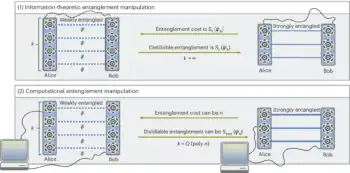A new twist on a classic experiment could show that pairs of electrons behave as bosons, despite the fact that single electrons are fermions. Peter Samuelsson and Markus Büttiker of the University of Geneva in Switzerland propose an update of the Hanbury Brown-Twiss experiment that would probe the pairs of electrons found in many superconductors. The pioneering experiment originally illustrated a fundamental difference in the quantum behaviour of bosons and fermions (P Samuelsson and M Büttiker 2002 Phys. Rev. Lett. 89 046601).
Quantum mechanics predicts that any number of bosons in a system can occupy the same quantum state, so that they can ‘cluster together’. In their 1950s experiment, Robert Hanbury Brown and Richard Twiss confirmed this prediction when they sent a beam of photons – which are bosons – through a beam splitter and measured the intensity of the two resulting beams. They found that the intensities of these beams were ‘positively correlated’ – that is, the peaks in the signals coincided, showing that photons can indeed bunch together. This behaviour is predicted by Bose-Einstein statistics.
In contrast, fermions – such as electrons – cannot share the same quantum state, and the experiment was recently adapted to test this prediction with a beam of electrons. The beam was split into two, and the currents of these beams were found to be ‘negatively correlated’ – when an electron was detected in one of the beams there was no electron in the other, and vice versa. This confirmed that electrons obey Fermi-Dirac statistics.
Physicists then began to speculate how pairs of electrons might behave. In conventional superconductors, electrons overcome their mutual repulsion to form ‘Cooper pairs’, which are propelled through the superconductor by lattice vibrations known as phonons. Now Samuelsson and Büttiker say that these pairs of electrons could show the positive correlation usually associated with bosons.
The researchers propose a set-up in which a quantum dot is connected to two normal conductors and a superconductor. An applied voltage would propel electrons into the normal conductors from the superconductor. But due to the ‘proximity effect’ – in which a superconductor induces superconductivity in an adjacent conductor – the electrons would travel across the quantum dot not singly, but in pairs.
Samuelsson and Büttiker calculated the currents that would flow from the quantum dot into the normal conductors, and found a positive correlation similar to that originally observed in the split beam of photons. This suggests that some of the pairs would split up when they reached the normal conductors, with one electron entering each conductor. This would show that the pairs of electrons behave as bosons, even though single electrons are fermions.
“Interestingly, the underlying statistics is still fermionic, but the association between the electrons make the positive correlations possible,” Büttiker told PhysicsWeb.



